Thalaiyasingam Ajanthan
Learning Visual Hierarchies with Hyperbolic Embeddings
Nov 26, 2024Abstract:Structuring latent representations in a hierarchical manner enables models to learn patterns at multiple levels of abstraction. However, most prevalent image understanding models focus on visual similarity, and learning visual hierarchies is relatively unexplored. In this work, for the first time, we introduce a learning paradigm that can encode user-defined multi-level visual hierarchies in hyperbolic space without requiring explicit hierarchical labels. As a concrete example, first, we define a part-based image hierarchy using object-level annotations within and across images. Then, we introduce an approach to enforce the hierarchy using contrastive loss with pairwise entailment metrics. Finally, we discuss new evaluation metrics to effectively measure hierarchical image retrieval. Encoding these complex relationships ensures that the learned representations capture semantic and structural information that transcends mere visual similarity. Experiments in part-based image retrieval show significant improvements in hierarchical retrieval tasks, demonstrating the capability of our model in capturing visual hierarchies.
Guiding Neural Collapse: Optimising Towards the Nearest Simplex Equiangular Tight Frame
Nov 02, 2024



Abstract:Neural Collapse (NC) is a recently observed phenomenon in neural networks that characterises the solution space of the final classifier layer when trained until zero training loss. Specifically, NC suggests that the final classifier layer converges to a Simplex Equiangular Tight Frame (ETF), which maximally separates the weights corresponding to each class. By duality, the penultimate layer feature means also converge to the same simplex ETF. Since this simple symmetric structure is optimal, our idea is to utilise this property to improve convergence speed. Specifically, we introduce the notion of nearest simplex ETF geometry for the penultimate layer features at any given training iteration, by formulating it as a Riemannian optimisation. Then, at each iteration, the classifier weights are implicitly set to the nearest simplex ETF by solving this inner-optimisation, which is encapsulated within a declarative node to allow backpropagation. Our experiments on synthetic and real-world architectures for classification tasks demonstrate that our approach accelerates convergence and enhances training stability.
Self-Supervision Improves Diffusion Models for Tabular Data Imputation
Jul 25, 2024



Abstract:The ubiquity of missing data has sparked considerable attention and focus on tabular data imputation methods. Diffusion models, recognized as the cutting-edge technique for data generation, demonstrate significant potential in tabular data imputation tasks. However, in pursuit of diversity, vanilla diffusion models often exhibit sensitivity to initialized noises, which hinders the models from generating stable and accurate imputation results. Additionally, the sparsity inherent in tabular data poses challenges for diffusion models in accurately modeling the data manifold, impacting the robustness of these models for data imputation. To tackle these challenges, this paper introduces an advanced diffusion model named Self-supervised imputation Diffusion Model (SimpDM for brevity), specifically tailored for tabular data imputation tasks. To mitigate sensitivity to noise, we introduce a self-supervised alignment mechanism that aims to regularize the model, ensuring consistent and stable imputation predictions. Furthermore, we introduce a carefully devised state-dependent data augmentation strategy within SimpDM, enhancing the robustness of the diffusion model when dealing with limited data. Extensive experiments demonstrate that SimpDM matches or outperforms state-of-the-art imputation methods across various scenarios.
Adaptive Cross Batch Normalization for Metric Learning
Mar 30, 2023



Abstract:Metric learning is a fundamental problem in computer vision whereby a model is trained to learn a semantically useful embedding space via ranking losses. Traditionally, the effectiveness of a ranking loss depends on the minibatch size, and is, therefore, inherently limited by the memory constraints of the underlying hardware. While simply accumulating the embeddings across minibatches has proved useful (Wang et al. [2020]), we show that it is equally important to ensure that the accumulated embeddings are up to date. In particular, it is necessary to circumvent the representational drift between the accumulated embeddings and the feature embeddings at the current training iteration as the learnable parameters are being updated. In this paper, we model representational drift as distribution misalignment and tackle it using moment matching. The result is a simple method for updating the stored embeddings to match the first and second moments of the current embeddings at each training iteration. Experiments on three popular image retrieval datasets, namely, SOP, In-Shop, and DeepFashion2, demonstrate that our approach significantly improves the performance in all scenarios.
Understanding and Improving the Role of Projection Head in Self-Supervised Learning
Dec 22, 2022Abstract:Self-supervised learning (SSL) aims to produce useful feature representations without access to any human-labeled data annotations. Due to the success of recent SSL methods based on contrastive learning, such as SimCLR, this problem has gained popularity. Most current contrastive learning approaches append a parametrized projection head to the end of some backbone network to optimize the InfoNCE objective and then discard the learned projection head after training. This raises a fundamental question: Why is a learnable projection head required if we are to discard it after training? In this work, we first perform a systematic study on the behavior of SSL training focusing on the role of the projection head layers. By formulating the projection head as a parametric component for the InfoNCE objective rather than a part of the network, we present an alternative optimization scheme for training contrastive learning based SSL frameworks. Our experimental study on multiple image classification datasets demonstrates the effectiveness of the proposed approach over alternatives in the SSL literature.
Retrieval Augmented Classification for Long-Tail Visual Recognition
Feb 22, 2022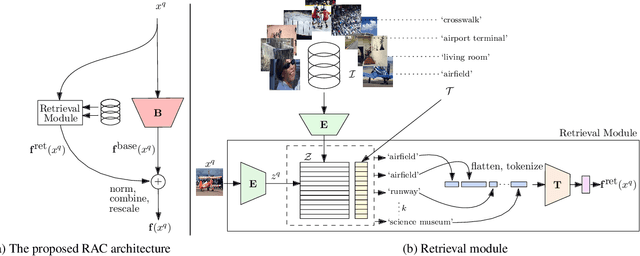
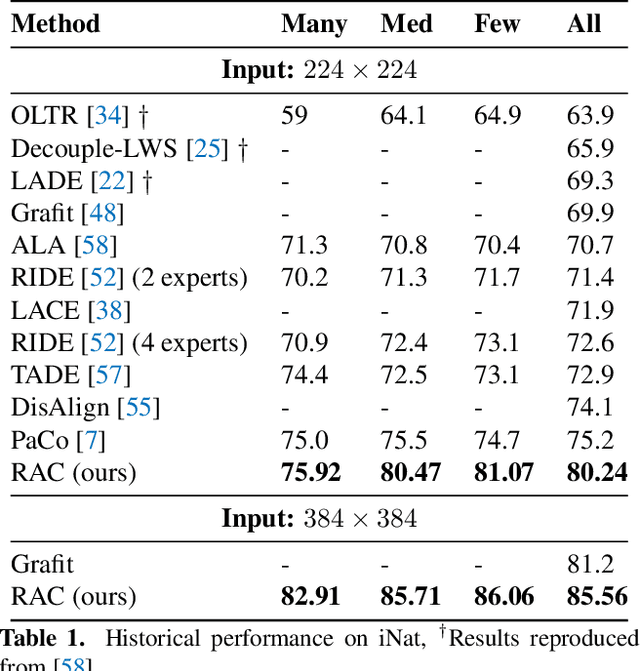
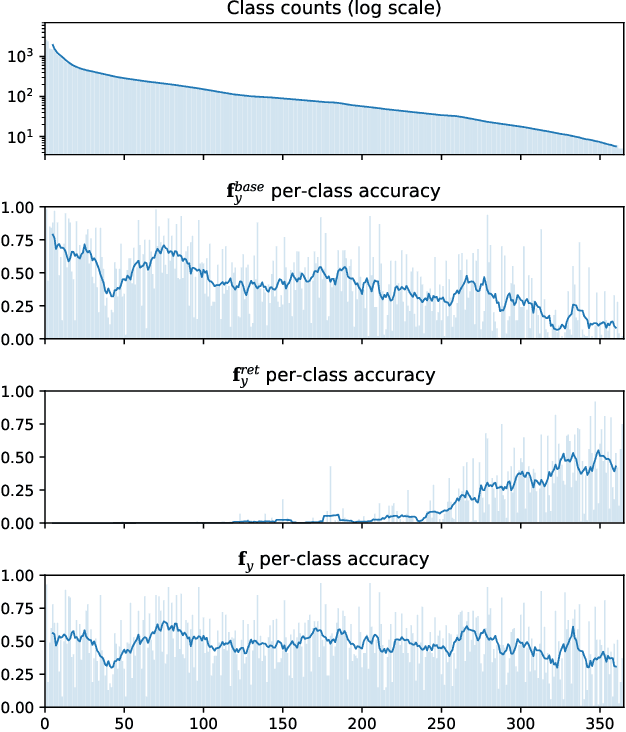
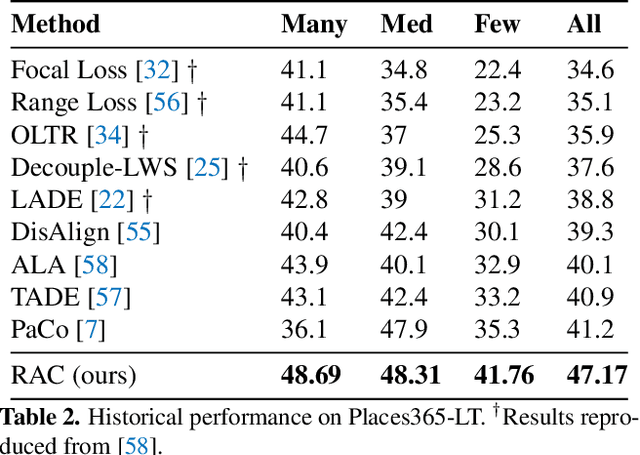
Abstract:We introduce Retrieval Augmented Classification (RAC), a generic approach to augmenting standard image classification pipelines with an explicit retrieval module. RAC consists of a standard base image encoder fused with a parallel retrieval branch that queries a non-parametric external memory of pre-encoded images and associated text snippets. We apply RAC to the problem of long-tail classification and demonstrate a significant improvement over previous state-of-the-art on Places365-LT and iNaturalist-2018 (14.5% and 6.7% respectively), despite using only the training datasets themselves as the external information source. We demonstrate that RAC's retrieval module, without prompting, learns a high level of accuracy on tail classes. This, in turn, frees the base encoder to focus on common classes, and improve its performance thereon. RAC represents an alternative approach to utilizing large, pretrained models without requiring fine-tuning, as well as a first step towards more effectively making use of external memory within common computer vision architectures.
Few-shot Weakly-Supervised Object Detection via Directional Statistics
Mar 25, 2021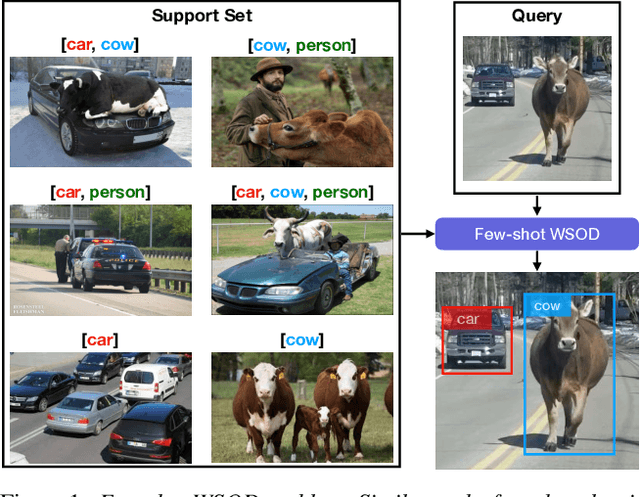



Abstract:Detecting novel objects from few examples has become an emerging topic in computer vision recently. However, these methods need fully annotated training images to learn new object categories which limits their applicability in real world scenarios such as field robotics. In this work, we propose a probabilistic multiple instance learning approach for few-shot Common Object Localization (COL) and few-shot Weakly Supervised Object Detection (WSOD). In these tasks, only image-level labels, which are much cheaper to acquire, are available. We find that operating on features extracted from the last layer of a pre-trained Faster-RCNN is more effective compared to previous episodic learning based few-shot COL methods. Our model simultaneously learns the distribution of the novel objects and localizes them via expectation-maximization steps. As a probabilistic model, we employ von Mises-Fisher (vMF) distribution which captures the semantic information better than Gaussian distribution when applied to the pre-trained embedding space. When the novel objects are localized, we utilize them to learn a linear appearance model to detect novel classes in new images. Our extensive experiments show that the proposed method, despite being simple, outperforms strong baselines in few-shot COL and WSOD, as well as large-scale WSOD tasks.
RANP: Resource Aware Neuron Pruning at Initialization for 3D CNNs
Oct 25, 2020



Abstract:Although 3D Convolutional Neural Networks (CNNs) are essential for most learning based applications involving dense 3D data, their applicability is limited due to excessive memory and computational requirements. Compressing such networks by pruning therefore becomes highly desirable. However, pruning 3D CNNs is largely unexplored possibly because of the complex nature of typical pruning algorithms that embeds pruning into an iterative optimization paradigm. In this work, we introduce a Resource Aware Neuron Pruning (RANP) algorithm that prunes 3D CNNs at initialization to high sparsity levels. Specifically, the core idea is to obtain an importance score for each neuron based on their sensitivity to the loss function. This neuron importance is then reweighted according to the neuron resource consumption related to FLOPs or memory. We demonstrate the effectiveness of our pruning method on 3D semantic segmentation with widely used 3D-UNets on ShapeNet and BraTS'18 as well as on video classification with MobileNetV2 and I3D on UCF101 dataset. In these experiments, our RANP leads to roughly 50-95 reduction in FLOPs and 35-80 reduction in memory with negligible loss in accuracy compared to the unpruned networks. This significantly reduces the computational resources required to train 3D CNNs. The pruned network obtained by our algorithm can also be easily scaled up and transferred to another dataset for training.
Deep Learning Superpixel Semantic Segmentation with Transparent Initialization and Sparse Encoder
Oct 09, 2020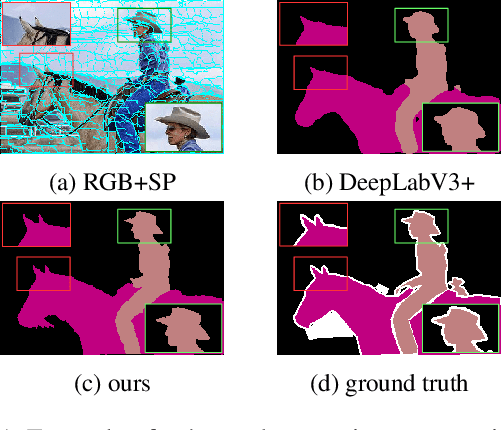
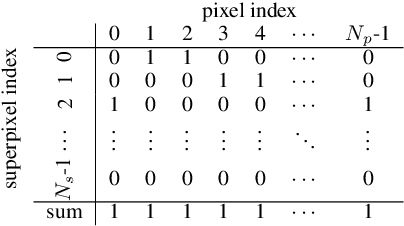
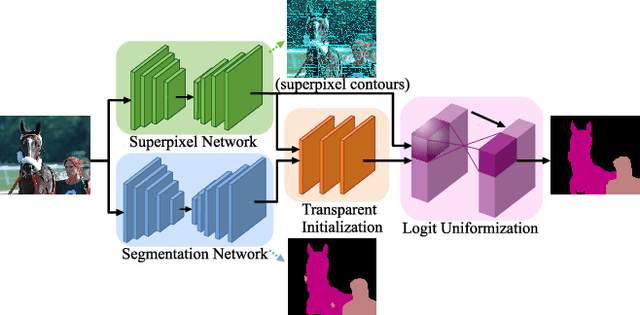

Abstract:Even though deep learning greatly improves the performance of semantic segmentation, its success mainly lies on object central areas but without accurate edges. As superpixel is a popular and effective auxiliary to preserve object edges, in this paper, we jointly learn semantic segmentation with trainable superpixels. We achieve it by adding fully-connected layers with transparent initialization and an efficient logit uniformization with a sparse encoder. Specifically, the proposed transparent initialization reserves the effects of learned parameters from pretrained networks, one for semantic segmentation and the other for superpixel, by a linear data recovery. This avoids a significant loss increase by using the pretrained networks, which otherwise can be caused by an inappropriate parameter initialization on the added layers. Meanwhile, consistent assignments to all pixels in each superpixel can be guaranteed by the logit uniformization with a sparse encoder. This sparse encoder with sparse matrix operations substantially improves the training efficiency by reducing the large computational complexity arising from indexing pixels by superpixels. We demonstrate the effectiveness of our proposal by transparent initialization and sparse encoder on semantic segmentation on PASCAL VOC 2012 dataset with enhanced labeling on the object edges. Moreover, the proposed transparent initialization can also be used to jointly finetune multiple or a deeper pretrained network on other tasks.
Post-hoc Calibration of Neural Networks
Jun 23, 2020



Abstract:Calibration of neural networks is a critical aspect to consider when incorporating machine learning models in real-world decision-making systems where the confidence of decisions are equally important as the decisions themselves. In recent years, there is a surge of research on neural network calibration and the majority of the works can be categorized into post-hoc calibration methods, defined as methods that learn an additional function to calibrate an already trained base network. In this work, we intend to understand the post-hoc calibration methods from a theoretical point of view. Especially, it is known that minimizing Negative Log-Likelihood (NLL) will lead to a calibrated network on the training set if the global optimum is attained (Bishop, 1994). Nevertheless, it is not clear learning an additional function in a post-hoc manner would lead to calibration in the theoretical sense. To this end, we prove that even though the base network ($f$) does not lead to the global optimum of NLL, by adding additional layers ($g$) and minimizing NLL by optimizing the parameters of $g$ one can obtain a calibrated network $g \circ f$. This not only provides a less stringent condition to obtain a calibrated network but also provides a theoretical justification of post-hoc calibration methods. Our experiments on various image classification benchmarks confirm the theory.
 Add to Chrome
Add to Chrome Add to Firefox
Add to Firefox Add to Edge
Add to Edge